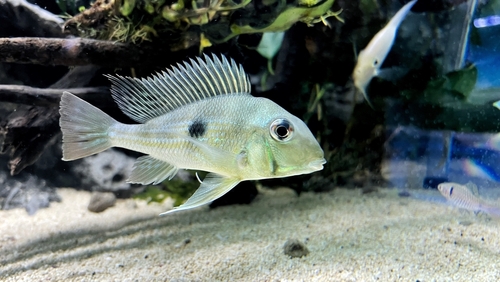Most aquarium enthusiasts want to put together a vibrant and exciting community, which means finding some fish friends that can actually get along. Unfortunately, this can be easier said than done. If you don’t want to end up with a fight on your hands, then you need to know some great Geophagus tank mates that are both compatible and beautiful.
That’s where we can help! For this article, we have come up with the most suitable new housemates for your Geophagus Altifrons so that they can live side-by-side in harmony – and so you can relax knowing that your tank is a happy and healthy place.
Contents
What To Know – Geophagus Tank Mates
Geophagus Altifrons is a very popular fish for home aquariums, and their vibrant and varied coloring certainly makes them a striking centerpiece. If you don’t want them to be the only inhabitants in your tank, though, you need to know a few important things about who they are able to live with.
As a relatively large and moderately active species, they can’t be thrown into an environment with just anybody – and their longer fins can make them look like a target to nippers and more aggressive fishy friends.
Tank Setup and Water Parameters
Before you start thinking about anything else, you need to make sure that the tank and water are perfect for your Geophagus and, consequently, any additional fish will need to be able to thrive under the same conditions.
For example, Geophagus Altifrons roughly translates to Earth Eaters because they actually scoop up the substrate in their tank with their mouths in order to feed. That means that they need nice fine sand or gravel so that they can do this safely. Therefore, you want the other fish that join them to enjoy the same kind of substrate.
The real deal breakers, though, will be in the water that they can thrive in and the amount of space they need. Geophagus Altifrons like to live in:
- Water Temp: 79°F – 82°F
- Hardness: 0 – 8 Kh
- pH Levels: 4.8 – 6.6
- Minimum Tank Size: 55 gallons
Size When Fully Grown
More often than not, the number one factor that will affect whether two fish from different species will get along with each other is their relative size. Larger aggressive fish almost always cause stress and potentially even harm to smaller fish, which may be viewed as a meal or simply an annoyance.
You would usually aim to house fish that are around the same size in one tank. Although Geophagus Altifrons is relatively gentle with species that are not too much smaller, they are slightly vulnerable to bigger and more dominant fish. They usually grow to around 8 inches as a maximum, so you should be looking for other fish that are no larger than this.
Personality/Temperament
A compatible temperament is also going to be key to creating a friendly and peaceful environment. Geophagus Altifrons are pretty peaceful and non-aggressive most of the time so they are happiest with other fish that have similarly easygoing personalities.
They are relatively active as well though, especially around the bottom of the tank, so they can cause a bit of stress to less energetic or territorial bottom-dwellers.
Resource Competition
It’s very important that every individual within your tank has access to the space, food, and activities that they need in order to thrive. That’s why you need to make sure any tank mates that you are putting together are not going to be competing for the same resources.
Due to their way of feeding, Geophagus will spend most of their time at the bottom of the tank so fish that roam around in the upper levels will usually be out of their way. If you are considering another bottom-dweller, then it should be a fish that is not too territorial or aggressive and is willing to share its space.
8 Most Compatible Geophagus Tank Mates
With a solid understanding of what we are looking for, we can start to really explore the different kinds of fish that could make a happy home with your Geophagus Altifrons.
You will also like these other top posts in this category:
1. Apistogramma Dwarf Cichlid
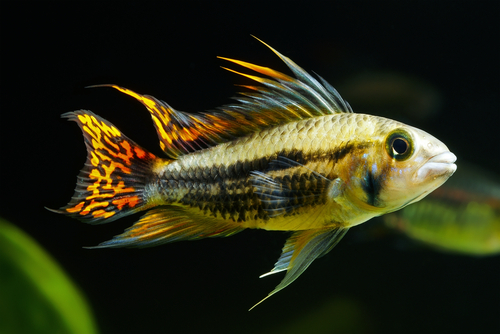
- Scientific Name: Apistogramma
- Adult Size: 3 – 4 inches
- Care: Moderate
- Other Tank Mates: Neon Tetras, Rasboras, Octocinclus Catfish
- Origin: South America
Quite a lot of dwarf cichlid species can make good tankmates for your Geophagus Antifrons because they are much smaller than their more aggressive and domineering counterparts. The Apistogramma Dwarf Cichlid is quite a wide and varied genus to choose from with lots of attractive and sociable options.
They are small in size but big in personality. These are an inquisitive and friendly species that have a long history of popularity in the aquarium hobby due to how interactive they can be with their owners. They make a good addition to many community tanks, but they will need some space to roam around at the bottom of the tank.
2. Congo Tetra
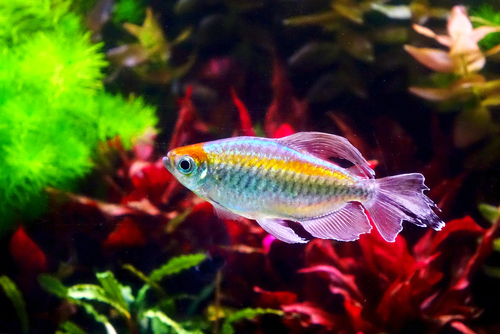
- Scientific Name: Phenacogrammus interruptus
- Adult Size: 3 – 4 inches
- Care: Easy
- Other Tank Mates: Guppies, Platies, Other Tetras
- Origin: Congo River Basin, Africa
Tetras are very well known as excellent aquarium fish, but most species are on the smaller side and may become stressed or anxious when they are housed with a Geophagus Altifrons. The Congo Tetra, however, grows to be pretty large in comparison and will appreciate how peaceful and calm your Geophagus are.
One of the most appealing things about Tetras, in general, is how easy they are to look after, and Congo Tetras are no different. They tend to spend most of their time relaxing in the middle and upper parts of the tank too, so they will stay out of the way of your Geophagus.
3. Corydoras Catfish

- Scientific Name: Corydoras paleatus
- Adult Size: 1 – 5 inches
- Care: Easy
- Other Tank Mates: Tetras, Barbs, Plecos
- Origin: South America
You may well have heard of the friendly and sociable Cory Catfish since they are incredibly common in community tanks, for good reason. They are sweet-natured and will be comfortable with a wide variety of other fish, and they are a breeze to care for as well.
While they are bottom-dwellers, they tend to keep to themselves and will stay out of your Geophagus’ way, particularly if you give them a nice little cave to hide out in. They are pretty hardy, too, so they are not too demanding when it comes to their environment.
4. Bristlenose Pleco
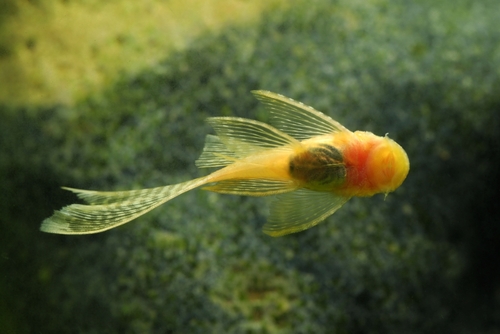
- Scientific Name: Ancistrus cirrhosus
- Adult Size: 6 inches
- Care: Easy
- Other Tank Mates: Kuhli Loach, Mollies, Guppies
- Origin: South America
This is another bottom-dweller that can happily share the lower portion of the tank. Bristlenose Plecos are a very docile bunch and they will be more than comfortable relaxing in a corner while your Geophagus roams around. They tend to suction in one place and very slowly make their way around for most of the day.
Bristlenose Plecos are algae eaters and will help control algae growth in the tank. They also have a wonderfully unique appearance, with a bristly facial structure that gives them their name and a lovely pattern across their bodies. There are few community tanks that a Bristlenose Pleco wouldn’t suit, so they are a go-to for many hobbyists.
5. Severum Cichlid
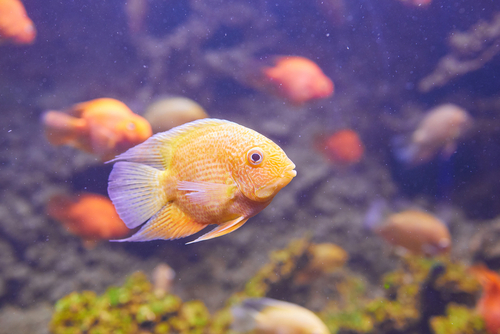
- Scientific Name: Heros severus
- Adult Size: 8-10 inches
- Care: Moderate
- Other Tank Mates: Dwarf Gourami, Angelfish, Tetras
- Origin: South America
As we mentioned before, cichlids have a bit of a reputation for being aggressive and bossy but Severums are another exception. They have easy-going personalities and will rarely get into confrontations in the tank – especially if they have a lot of room to move around in.
They can vary quite significantly in appearance but most will have a yellow-gold color with orange accents and may have large vertical black bands, which is why you will sometimes hear them referred to as “Banded Cichlids.” They are pretty low maintenance and are a good choice for people who are relatively new to the hobby, but just like Geophagus, they like to dig, and my start “redecorating” you tank!
6. Clown Loach
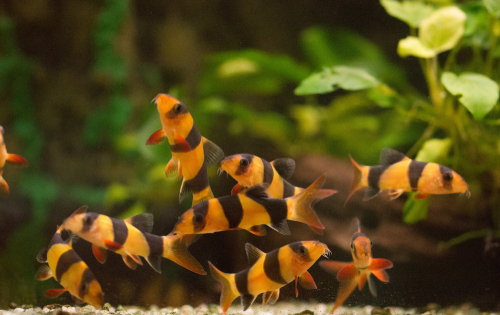
- Scientific Name: Chromobotia macracanthus
- Adult Size: 8 – 10 inches
- Care: Intermediate
- Other Tank Mates: Barbs, Danios, Gouramis
- Origin: Indonesia
The Clown Loach is another addition to this list that is not just a great Geophagus tank mate, but a great tank mate in general. Despite their reasonably large size, they are very friendly and good-natured and they are quite playful and fun to observe too.
They usually have very bright orange bodies with thick black stripes down them, and they like to spend their time exploring the substrate or chasing each other around the tank. While they will occupy the same space as your Geophagus, they are very non-confrontational and will simply dart off if they get too close.
7. Angelfish

- Scientific Name: Pterophyllum scalare
- Adult Size: Approx. 6 inches
- Care: Moderate
- Other Tank Mates: Cory Catfish, Swordtails, Platies
- Origin: South America
There are few fish with a more iconic look than the famous Angelfish, and they really are wonderful to care for. Their incredible fins and distinctively patterned bodies make them a joy to look at, and their graceful way of floating around can keep you entertained for hours at a time.
They are particularly good tank mates for Geophagus as they like to occupy the upper parts of the tank so they won’t really compete for space at all. The lovely flowing fins on these fish make them vulnerable to known fin nippers, and there aren’t too many large species that they can be comfortable living alongside.
8. Denison Barb

- Scientific Name: Puntius denisonii
- Adult Size: 3 – 6 inches
- Care: Easy
- Other Tank Mates: Large Tetras, Other Barbs, Celestial Pearl Danios
- Origin: Southern India
There are loads of excellent species of barb out there, but a lot of them are so small that they might find your Geophagus a little intimidating. The Denison Barb, however, is larger and a little more self-assured.
Also known as the Roseline Shark, they have long silver bodies that are highlighted by bright splashes of red, yellow, and gold, with a single lateral stripe running down their sides. They like to have a lot of room to roam so they enjoy a bigger tank, just like your Geophagus does!
Summary: Best Tank Mates For Geophagus
So, who could you choose as an ideal tank mate for Geophagus Altifrons? Well, you’re looking for somebody who is relatively easy-going, grows about 8 inches in size or less, and isn’t going to get upset about sharing the bottom of the tank.
There are a few great options out there, like small Cichlids, large Tetras, large Barbs, and fish that are well-known to be easygoing and carefree like the Clown Loach and the Bristlenose Pleco.
While it is easier to find friends for a Geophagus than it can be for some other species, you still need to make sure that the needs of every single individual in the tank are going to be met so that they can all thrive together.

JJ has had a passion for learning about aquatic life since age 5. As an adult, he made his passion a career as a certified aquaculture dealer and aquarium content creator.


